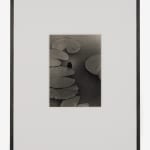Benita Koch-Otte
Benita Koch-Otte, an influential figure in the realm of textile design and photography, made substantial contributions to the Bauhaus, a crucible of modernist design. Born in 1892 in Stuttgart, Germany, Benita Koch-Otte was part of the Weimar Bauhaus from 1920 to 1925 and later at the Dessau Bauhaus until 1933. Her journey through art was marked by a commitment to the school’s ethos of combining crafts and fine arts, with a focus on functionality and simplicity in design. At the Bauhaus, Koch-Otte worked closely with Gunta Stölzl in the weaving workshop, where she developed her signature textile works characterized by geometric abstraction and innovative use of materials. Beyond her textiles, Koch-Otte also explored photography, a medium she used to document and study forms and patterns found in nature and everyday life.
The photograph ‘Water Lily,’ a gelatin silver print from circa 1930, serves as a testament to Koch-Otte's sensitivity towards natural subjects and the abstract potential within them. In the context of her and her husband Heinrich Koch's photographic endeavors, this image mirrors the Bauhaus preoccupation with form, light, and shadow. Heinrich Koch was also associated with the Bauhaus and was a noted photographer in his own right. The couple's shared aesthetic sensibilities are evident in their photographs, with an attention to the play of light, composition, and the subtleties of grayscale, which embody the New Objectivity movement's influence on Bauhaus artists. Benita's work often paralleled Heinrich's, focusing on the interplay between light and form, but her unique perspective as a textile designer allowed her to explore textures and patterns in a distinct, tactile manner.
‘Water Lily’ as a visual work reflects the modern photographic aesthetic embraced by the Bauhaus during its most influential years. The photograph is characterized by a clear composition, capturing the tranquility of a pond surface punctuated by the floating lily pads. The interplay of light and dark is skillfully managed, with the dark water serving as a canvas for the organic shapes of the lily pads. The gelatin silver print medium, popular at the time for its precision and range of tonalities, perfectly suits Koch-Otte's intent to convey not just the physicality of the lilies, but also the serene atmosphere of the scene. The subtle textures, the contrast between the lily pads and the reflective water, and the overall minimalist composition align with the Bauhaus aesthetic, which sought to strip away the superflous and focus on the elemental aspects of form and function. This image stands as a fine example of how Benita Koch-Otte's work resonates with the core principles of the Bauhaus—synthesis of art and technology, the significance of simple geometric forms, and the embrace of new techniques to create art that reflected the spirit of modernity.
NOTES
The present gelatin silver print photograph presents the photographer's estate stamp annotated '12/IIV' in pencil on the verso.
Provenance
The artist's estatePrivate collection, United States
Private collection, New York




